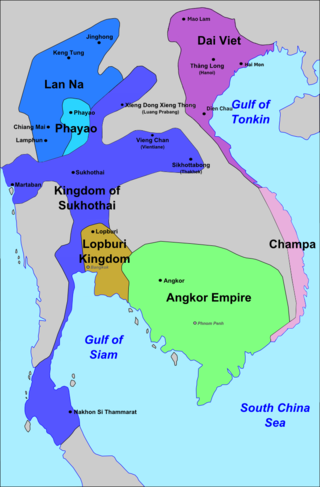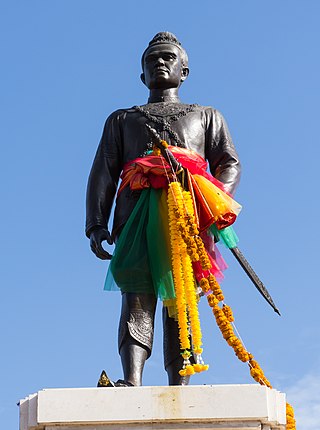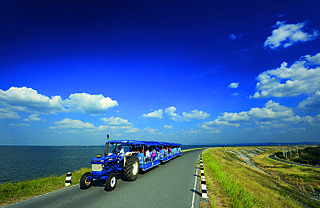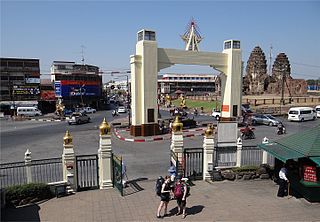
The Tai ethnic group migrated into mainland Southeast Asia over a period of centuries. The word Siam may have originated from Pali, Sanskrit श्याम, or Mon ရာမည, with likely the same root as Shan and Ahom. Xianluo was the Chinese name for the Ayutthaya Kingdom, merged from Suphannaphum city-state, centered in modern-day Suphan Buri; and Lavo city-state, centered in modern-day Lop Buri. To the Thai, the name of their country has mostly been Mueang Thai.

The Ayutthaya Kingdom or the Empire of Ayutthaya was a Mon and later Siamese kingdom that existed in Southeast Asia from 1351 to 1767, centered around the city of Ayutthaya, in Siam, or present-day Thailand. European travellers in the early 16th century called Ayutthaya one of the three great powers of Asia. The Ayutthaya Kingdom is considered to be the precursor of modern Thailand, and its developments are an important part of the history of Thailand.

The Sukhothai Kingdom or the Northern Cities was a post-classical Siamese kingdom (mandala) in Mainland Southeast Asia surrounding the ancient capital city of Sukhothai in present-day north-central Thailand. The kingdom was founded by Sri Inthrathit in 1238 and existed as an independent polity until 1438, when it fell under the influence of the neighboring Ayutthaya after the death of Borommapan.

King U-thong or KingRamathibodi I was the first king of the kingdom Ayutthaya, reigning from 1351 to 1369.

Lopburi is a province in the central region of Thailand. The province is divided into 11 administrative districts, and Mueang Lopburi district is the capital. With over 750,000 people, the province is Thailand's 36th largest area and 32nd most populous. There are eight neighboring provinces, Phetchabun, Chaiyaphum, Nakhon Ratchasima, Saraburi, Phra Nakhon Si Ayutthaya, Ang Thong, Sing Buri, and Nakhon Sawan.

Haripuñjaya was a Mon kingdom in what is now Northern Thailand, existing from the 7th or 8th to 13th century CE. Its capital was at Lamphun, which at the time was also called Haripuñjaya. In 1292 the city was besieged and captured by Mangrai of the Tai kingdom of Lan Na.

Lopburi is the capital city of Lopburi Province in Thailand. It is about 150 kilometres (93 mi) northeast of Bangkok. It has a population of 58,000. The town covers the whole tambon Tha Hin and parts of Thale Chup Son of Mueang Lopburi District, a total area of 6.85 km2.

Dvaravati was an ancient Mon political principality from the 6th century to the 11th century, located in the region now known as central Thailand, and was speculated to be a succeeding state of Lang-chia or Lang-ya-hsiu (หลังยะสิ่ว). It was described by Chinese pilgrims in the middle of the 7th century as a Buddhist kingdom named To-lo-po-ti situated to the west of Isanapura (Cambodia), to the east of Sri Ksetra (Burma), and adjoined Pan Pan in the South. Its northern border met Chia-lo-she-fo, which was speculated to be either Kalasapura, situated along the coast of the Bay of Bengal somewhere between Tavoy and Rangoon, or Canasapura in modern northeast Thailand. Dvaravati sent the first embassy to the Chinese court in around 605–616.

Thai art refers to a diverse range of art forms created in Thailand from prehistoric times to the present day, including architecture, sculpture, painting, textiles, decorative arts, crafts, ceramics, and more. While Buddhism has played a significant role in Thai art, with many sculptures and paintings depicting Buddha images and religious themes, nature, including flora and fauna, as well as mythical creatures, has been a major inspiration for Thai art, with colorful motifs appearing in various types of art forms. In contemporary Thai art, traditional works remain significant and continue to influence artists' concepts.

Thai people, Chao Phraya Thai, Central Thai people, Southern Thai people, Siamese, Thai Siam, Tai Noi people, are a Southeast Asian ethnic group native to Thailand. In a narrower sense, the Thais are also a Tai ethnic group dominant in Central and Southern Thailand. Part of the larger Tai ethno-linguistic group native to Southeast Asia as well as Southern China and Northeast India, Thais speak the Sukhothai languages, which is classified as part of the Kra–Dai family of languages. The majority of Thais are followers of Theravada Buddhism.

Tambralinga was an Indianised kingdom located on the Malay Peninsula, existing at least from the 2nd to 13th centuries CE. It was under the influence of Srivijaya for some time, but later became independent from it. The name had been forgotten until scholars recognized Tambralinga as Nakhon Si Thammarat. In Sanskrit and Prakrit, tām(b)ra means "copper", "copper-coloured" or "red" and linga means "symbol" or "creation", typically representing the divine energy of Shiva.

Known as "Lavo" during most of its history, Lopburi Province is one of the most important cities in the history of Thailand. The city has a long history, dating back into the prehistory period since the Bronze Age of more than 3,500 years ago.

Before the Tai people's southward migration from Guangxi since the 4th century, the Indochinese peninsula had already been populated by Australo-Melanesians who by around 30,000 BP had spread into all sub-regions. They left traces of the first local culture - the Hoabinhian, a name assigned to an industry and cultural continuity of stone tools and flaked cobble artifacts that appears around 10,000 BP in caves and rock shelters first described in Hòa Bình, Vietnam, later also documented in Terengganu, Malaysia, Sumatra, Thailand, Laos, Myanmar, Cambodia and Yunnan, southern China.

Singhanavati was a Tai semi-legendary kingdom based along the Kok River in the Chiang Rai Basin in northern Thailand, existed from 691 BCE to 638 CE. It was centered in Yonok Nahaphan and then moved to Wieng–Prueksha after the old capital was submerged below Chiang Saen Lake due to an earthquake in 545.

Borommarachathirat II or Borom Rachathirat II, also known as King Samphraya (1386–1448), was a king of Ayutthaya. His reign saw its early expansions.

The Nyah Kur are an ethnic group native to Thailand in Southeast Asia. Closely related to the Mon people, the Nyah Kur are the descendants of the Mon of Dvaravati who did not flee westward or assimilate when their empire fell under the influence of the Khmer when Suryavarman I gained the throne in the early 11th century.
The Camadevivamsa is a Pali chronicle composed in the early 15th century by the Lanna Buddhist monk Mahathera Bodhiramsi. The chronicle, dated to c. 1410, is a semi-historical recounting of the founding of the Mon Dvaravati kingdom of Hariphunchai (Haripunjaya) in the mid-sixth century by Queen Cāmadevi and her establishment of a lineage destined to rule Haripunchai for the next 500 years. The manuscript ends with King Adittaraja's discovery of a sacred relic of the Buddha in the eleventh century that became central to the Theravada Buddhist culture of Haripunchai and is still enshrined in Wat Phradhatu Haripunjaya in present-day Lamphun, Thailand. In addition to the Camadevivamsa, which is also known in English as The Legend of Queen Cama and The Chamadevivongs, Bodhiramsi also composed, in 1417, the Tamnan Phraphutthasihing, another chronicle which describes the history of the Phra Phuttha Sihing image, from its creation in Ceylon to its enshrinement in 1411 at Chiang Mai, the capital of Lanna.

San Phra Kan is a Hindu/Buddhist shrine in the town of Lop Buri in Thailand. The original structure dates to the time of the Khmer Empire. It is a popular tourist attraction best known for the monkeys inhabiting the area.

Si Thep Historical Park is an archaeological site in Thailand's Phetchabun province. It covers the ancient city of Si Thep, a site inhabited from around the third to fifth century CE until the thirteenth century, spanning cultural periods from late prehistory, through Dvaravati, to the golden age of the Khmer Empire. Si Thep was one of the largest known city-states that emerged around the plains of central Thailand in the first millennium, but became abandoned around the time the Thai-speaking cities of Sukhothai and later Ayutthaya emerged as new centres of power in the Chao Phraya River basin.

Mueang Uthong is an archaeological site located in the U Thong district, Suphan Buri province. It was inhabited from around the 10th century BC and became the state society in the third to sixth-century CE. Uthong was one of the largest known city-states that emerged around the plains of central Thailand in the first millennium but became abandoned around 1000 AD due to the endemic and lost in major trading cities status. It was resettled in the Ayutthaya period but was abandoned again after the fall of Ayutthaya in the 1760s.






















